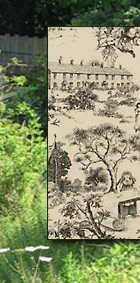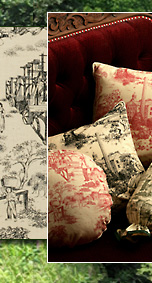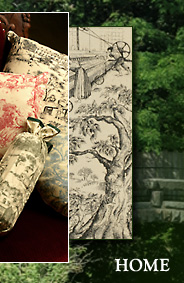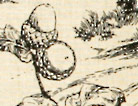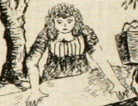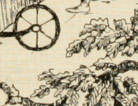![]()
Natural Victorian
Cotton Products

Woven By Water® Presents Authentic Victorian Toile Fabrics
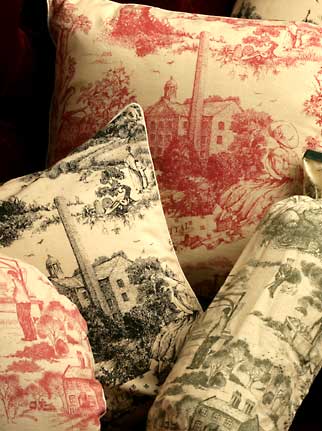 |
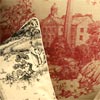 |
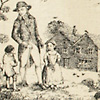 |
|
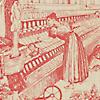 |
|
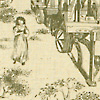 |
Come closer, take a look at this fascinating fabric. This is Toile, but wait, it's of a Weaving Mill! And the Mill still exists today, just as it is pictured in the fabric! Look closer and you will find fairies in the grass under the large tree, rabbits around the lady of the Mill, shuttles and bobbins. All sorts of animals and people come to life in this intricately detailed, original fabric.
This is the Quarry Bank Mill Toile.
It is the only known Toile to depict an English Weaving Mill and Village. It is also the only Toile to be produced in the original etching style using copper-plate rollers on cotton fabric woven in the original method using only water power. This is a rare find for those interested in authenticity in their fabrics.
View Fine Details of this Exceptional Novelty Toile Fabric.
** these files are very large and might take longer to view depending on your connection speed
Colors: Black, Green, or Red
Price and Dimensions:
Price per yard $21.80
Fabric is 47" wide and the repeat of the pattern is around 32".
Authentic Victorian Toile Fabric
$21.80/yard
(see shipping and handling rates)
Other items that use our Quarry Bank Mill Toile
Tea Cozies
Victorian Full Apron
The History of ToileToile, the subtly elegant printing technique that tells stories in engraving-like detail, traveled a fascinating history of its own to become the enduring favorite of designers, decorators and homeowners everywhere.
Toile, pronounced twal, is an abbreviation of toile de Jouy. The name comes from Jouy-en-Josas, France, where the first plant to commercially produce this type of printing was established in 1760. The initial toile was a monotone, one-color print, rendered in intricate, engraving-like detail on a white or cream-colored background.
The triumph of toile as today's decorative darling is far from simple, however. When Christopher-Philippe Oberkampf opened a print shop in France in 1760, reverse images for toile prints were carved into wooden blocks. Ink was applied to the blocks and then transferred by hand to un-dyed cotton. Only the rich and the royal, including Louis XVI, could afford the results of this painstaking process.
Later, in a stunning example of industrial espionage, Oberkampf discovered in England the secrets of etching designs onto a copper-plate roller. He and his brothers wrote the directions for this process on cotton percale fabric, using an alum solution tinted with red dye, and then dipped the fabric in vinegar to render the writing invisible until after they crossed the Channel. By utilizing their stolen information, the Oberkampfs significantly expanded both their market and their fame. Napoleon himself bestowed on them the Legion of Honor.
Still later, in an unrelated but ironic twist of fate, British troops destroyed Oberkampf's factory in Jouy-en-Josas. Brokenhearted, the printmaker died shortly afterwards.
Today, toile triumphs, but only the engraving-like quality of the printing method remains true to its original.
From a distance, toiles first emerge as a pleasing overall background design. On closer look, as these subtle images come into focus, they engage the onlooker and become as interesting as an engraved art print. Few other design techniques can accomplish the dual role of creating both an unobtrusive, elegantly discreet setting for all of the objects and furnishings in a room, and, at the same time, lend distinctive, standalone art to that interior.
Courtesy of ARA Content


